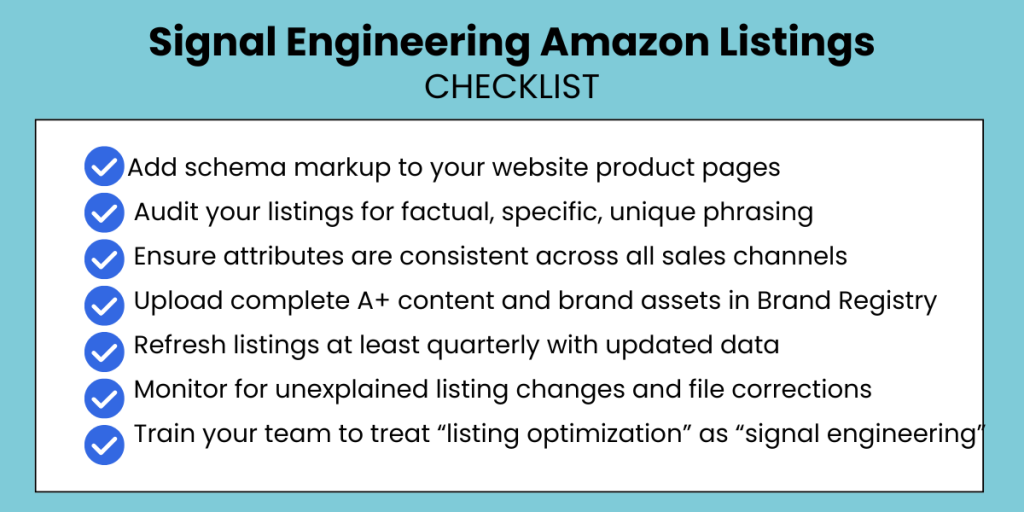Amazon is quietly transforming how product listings are built. With projects like Starfish, the company is deploying generative AI to enrich its vast catalog by pulling data from across the web, rewriting titles and descriptions and filling in missing attributes. The promise for buyers could mean fewer incomplete listings, better consistency and faster product discovery.
But for sellers, this shift raises an uncomfortable question. What happens when Amazon’s AI rewrites your listing and the version it chooses doesn’t come from you? Suddenly, the battle isn’t about keywords or conversion optimization. It’s about signal engineering for deliberately shaping your content and brand presence so that when Amazon’s AI decides what information to trust, it chooses your version. Sellers who don’t adapt risk losing control of their product story, their differentiators and ultimately, their sales.
This guide breaks down what’s happening inside signal engineering Amazon listings, why it matters for your business and how you can engineer your listings and brand content to stay in control.
What is Project Starfish and why should sellers care?
Project Starfish (as reported by Business Insider) is Amazon’s initiative to create the “ultimate source of truth” for product data. Instead of waiting for sellers or vendors to upload accurate details, the system can:
-
Crawl external sources like brand websites, manuals, and data feeds.
-
Rewrite incomplete or poorly formatted titles, bullet points, and descriptions.
-
Fill in missing attributes such as size, material, or use cases.
-
Create a smarter, more standardized catalog that benefits buyers.
On paper, that sounds efficient. But when multiple sources exist, signal engineering Amazon listings means Amazon has to choose which version of the truth to trust.
That means if your product specs on your brand site differ from what’s on a reseller’s page, or if your carefully written bullets conflict with scraped content the AI might overwrite your listing with someone else’s words. For private-label and brand-registered sellers, this is more than an inconvenience. It’s a direct threat to your brand voice, compliance and sales performance.
The signal engineering Amazon listings battleground: how AI decides what to trust
Generative AI systems like Starfish don’t just “copy and paste.” They weigh inputs based on signals of authority, structure and clarity. Think of it as a tug-of-war:
-
On one side, your version of the listing (optimized, polished, compliant).
-
On the other, a sea of competing signals (reseller copy, outdated distributor data, scraped content, or even customer reviews).
The AI’s job is to reconcile these sources into a single output. If your signals are weak, or inconsistent; your version may lose. This is why sellers must shift from simple listing optimization to signal engineering. It’s about designing your content and brand presence so Amazon’s AI prioritizes it.
7 ways to engineer authority signals for your Amazon listings
Here’s how you can strengthen the signals that Amazon’s AI looks for and increase the odds that your version becomes the “source of truth.”
1. Make your brand website a data hub
Your website isn’t just for customers anymore, it’s a critical input for Amazon’s AI. Use structured data (schema.org Product, Reviews, Offers) so machines can easily parse your specs. Ensure your product pages are complete, up to date, and consistent with your Amazon listing. Pro tip: Add FAQs and clearly formatted bullet-style features. These are easier for AI to extract than long paragraphs.
2. Strengthen Brand Registry assets
Amazon Brand Registry is a signal amplifier. Upload A+ Content, brand stories, and product documents directly into Seller Central. The more authoritative content Amazon already has from you, the less it needs to “fill in the blanks” from elsewhere.
3. Use unique anchor sentences
Generic copy like “high-quality and durable” is easily rewritten. Instead, create unique, fact-based sentences that can’t be paraphrased without losing meaning. Example:
-
Weak: “Durable stainless steel water bottle.”
-
Strong: “Brand X’s double-walled stainless steel bottle keeps drinks cold for 24 hours, verified by ASTM testing.”
This makes your copy harder for Amazon’s AI to replace with vague alternatives.
4. Keep product data consistent across channels
If your Shopify page lists one dimension and your Amazon listing another, you’ve handed the AI a reason to distrust both. Align your data across all touchpoints: website, distributor feeds, GS1 and Amazon. Consistency helps reinforce authority.
5. Leverage freshness as a ranking factor
AI often favors newer data. Update your listings and external sites regularly, especially with seasonal relevance or compliance updates. Even a small update cadence signals that your content is the most current version.
6. Create “resist-rewrite” zones
Design parts of your listing (like bullets) to be highly factual and concise, reducing the chance of AI rewriting them. Stick to verified features, specs and quantifiable benefits. The less subjective your copy, the more likely it is to survive intact.
7. Monitor for AI rewrites
Set up alerts or run regular audits to detect when your listing titles, bullets, or attributes change without your input. If you catch AI-driven changes early, you can file corrections or strengthen your signals before the rewritten version takes hold.
From optimization to signal engineering Amazon listings: a mindset shift
Traditional Amazon listing optimization focused on keywords, readability and conversion. That still matters, but in an AI-driven catalog, authority and consistency are the new frontier.
Instead of asking: “How can I rank higher in search?” You should also ask: “How can I make sure my version of the listing survives Amazon’s AI rewrites?” This mindset shift forces sellers to:
-
Think beyond keywords to data completeness and reliability.
-
View every channel (website, PR, distributor feeds) as inputs Amazon might scrape.
-
Invest in content marketing systems that maintain consistency across platforms.
The risks of ignoring AI-driven catalogs
Sellers who treat Amazon listings as “set it and forget it” are at growing risk. Common pitfalls include:
-
Loss of brand voice: Your careful positioning gets replaced by generic AI phrasing.
-
Incorrect data: If Amazon scrapes an outdated reseller site, your product specs could become inaccurate.
-
Compliance issues: AI hallucinations or overclaims (e.g. “FDA-approved”) could trigger policy violations.
-
Reduced conversion: Generic or unclear bullets lead to lower buyer trust and fewer sales.
In short, neglecting signal engineering isn’t just about losing control—it’s about losing revenue.
What’s next: AI-powered listings beyond Starfish
Amazon’s catalog AI is only the beginning. We’re already seeing:
-
Audio summaries (“Hear the Highlights”): AI-generated audio blurbs of your listing and reviews, meaning your phrasing may literally become the voice of your brand.
-
Conversational search (Rufus): Amazon’s assistant answers buyer queries directly, pulling from listings, reviews, and brand content. If your signals aren’t aligned, you may not be the recommended answer.
-
Generative Engine Optimization (GEO): As external search engines like Google shift toward AI answers, the same principles apply—structured, authoritative, consistent content gets cited first.
Practical signal engineering Amazon lisitng checklist

Save this quick reference and apply today.
-
Add schema markup to your product pages
-
Audit your listings for factual, specific, unique phrasing
-
Ensure attributes are consistent across all sales channels
-
Upload complete A+ content and brand assets in Brand Registry
-
Refresh listings at least quarterly with updated data
-
Monitor for unexplained listing changes and file corrections
-
Train your team to treat “listing optimization” as “signal engineering”
Amazon Sellers who control the signal will control the story
Amazon’s use of generative AI to build a smarter catalog is inevitable. For buyers, it’s a step toward cleaner, more reliable product pages. For sellers, it’s both a risk and an opportunity.
If you invest in signal engineering, strengthening the authority, clarity, and consistency of your content—you can tilt Amazon’s AI in your favor. Your version of the truth becomes the version of the truth. Those who ignore the shift risk waking up to find their listings rewritten, their brand diluted, and their sales slipping away.
Now is the time to act. Engineer your signals, future-proof your content and make sure Amazon’s AI tells your story, not someone else’s.Need help connecting the content dots? Reach out to Christina Ink today to boost traffic and conversions on Amazon and beyond.

Christina Passmore
CEO, Christina Ink
Christina Passmore helps Amazon sellers and agencies scale through content strategy, marketplace optimization and positioning. A former Amazon seller, she brings deep knowledge of Amazon listing optimization, account health, marketplace trends, and seller growth. When she’s not writing or analyzing listings, you’ll find her exploring the Rockies or working through a CrossFit WOD.


LIKE THIS ARTICLE?